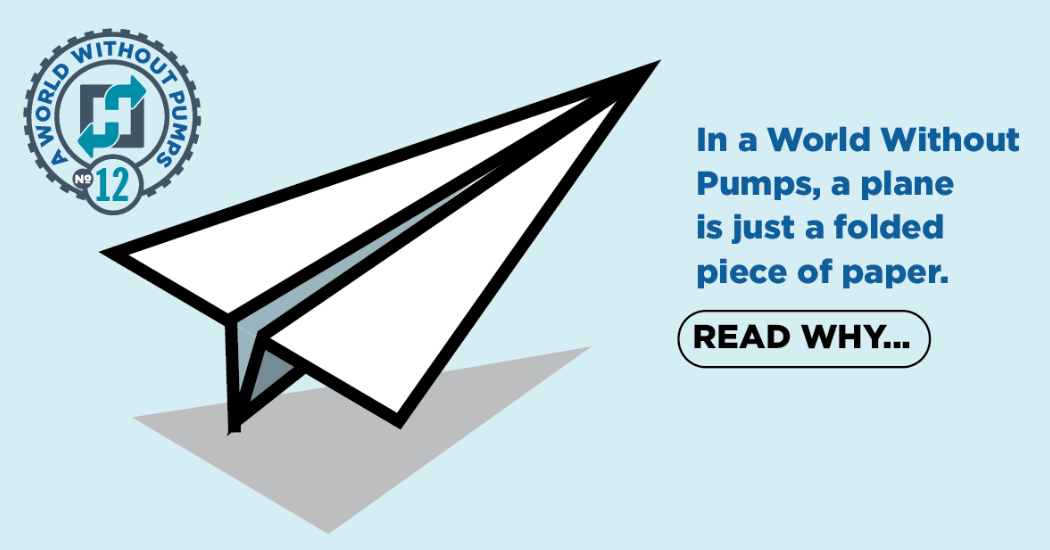Planes, Trains & Automobiles is a classic comedy that follows the misadventures of two unlikely travel companions who use every possible means to get from New York to Chicago. What may come as a surprise is that pumps play a critical role in every form of transportation, including planes, trains, and automobiles. In fact, without pumps, traveling by air, for example, would be as reliable as throwing a paper plane across the room and expecting it to land safely on a cocktail napkin 30 feet away.
Today, we explore the crucial role pumps play in transporting both people and goods in various ways.
Airplanes
Commercial aircraft are equipped with one or more dedicated hydraulic systems that operate various flight control surfaces, including:
- Flaps and slats
- Ailerons
- Rudder
- Elevator
- Horizontal stabilizer
- Spoilers
- Speed brakes
While various types of actuators perform the operations, pumps provide the necessary pressure and flow. Most are engine-driven pumps, which get their power from the rotation of the aircraft engines, although airflow will usually rotate the engines enough to drive the pumps and provide some hydraulic power in the event of engine failure. For such emergencies, a backup electrical pump is normally also used. Variable displacement piston pumps are the most common type of pump used on larger aircraft. They can compensate for changes in system demand by increasing or decreasing the fluid output while maintaining nearly constant system pressure. Fixed displacement piston pumps and gear pumps are also used in some applications.
Potable water used in aircraft restrooms and galleys is pumped from tank trucks or via hose lines into onboard tanks while the aircraft is on the ground. An electric pump on the aircraft pressurizes the water system to ensure a positive flow to the galley, washbasins, and toilets. For flights that are longer 20 hours, some aircraft are also equipped with showers as a luxury option for travelers who need to freshen up after long flight. At the other end of the flight, once the plane is parked on the ground, a dedicated lavatory service truck pumps the holding tanks empty and transports the waste to a facility for processing.
Commercial aircraft also require various types of support equipment to operate, much of which incorporates pumps. Low-profile tractors, called pushback tugs, often back planes away from the gate so they can taxi to the runway when pilots can’t see what’s behind them. They are also more efficient and quieter than running the aircraft engines. While some of these tugs connect to the plane’s nose gear with a towbar, more advanced towbarless designs use hydraulics to lift the nose landing gear wheels off the ground. Typical designs have a centralized hydraulic system with a load-sensing piston pump.
In cold, snowy or rainy weather, aircraft must be deiced before takeoff to prevent ice from forming on the wings and control surfaces during flight. Deicing trucks equipped with extended booms and spray nozzles can reach all critical areas to spray deicing fluid. Typically, these vehicles use diaphragm pumps to spray the fluid, but the boom movement usually is hydraulically actuated, with pumps providing the pressure to move the cylinders. Some of these vehicles are propelled by hydrostatic transmissions, in which a pump drives one or more hydraulic motors.
Trains
Before there were automobiles and trucks, railroads were the only practical way for passengers and goods to travel across the country. Until the mid-20th century, most locomotives were driven by steam and consumed a considerable amount of water. This was usually replenished at station stops, often by gravity from tanks that had to be filled by pumps or by water lines pressurized by pumps. With the advent of hybrid diesel-electric engines in the mid-20th century, their need for water disappeared along with the steam engines.
Behind the locomotives, there are several uses for pumps in the train itself. Passenger cars include pumps to supply water for the lavatories, and trains with dining cars also require water pumps to serve their gallies. For freight trains, pumps are used mainly for loading and unloading tank cars that carry petroleum and other chemical products.
A recent development is a project in New York City to convert some existing railcars to pump cars that can remove water from subway system tunnels during severe weather. Each pump car features a five-pump arrangement, including four inline submersible pumps and one horizontal pump. The submersible pumps will remove water from the tunnel, while the horizontal pump will pull water from especially low areas when the pump car itself is not submerged.
Automobiles and Other Vehicles
Transportation of passengers and materials requires a wide variety of motor vehicles, from the family passenger car to cross-country busses and motorhomes, as well as trucks ranging from pickups to tankers and box trucks. Semi tractors pull trailers hauling machinery, frozen foods and produce, lumber and steel, and liquids from milk to petroleum. In many cases, pumps provide vital support.
The motorhome a family owns or rents for its vacation may include both a water system pump and a waste pump to empty the holding tank. Cross country busses with lavatories also will have a water system that includes a pump. Tank trucks hauling liquids ranging from milk to petroleum are loaded and unloaded by pumps.
As for automobiles, most modern cars with direct injection have two fuel pumps (one regular and one high pressure), some have more. Then there is the windshield washer fluid pumps, some cars have multiple pumps (one for the windshield, one for the headlight washers).
All of these vehicles are fueled by gasoline or diesel fuel that is stored in underground tanks and pumped to dispensers at a service station. This requires either a submersible pump located in the station’s tank or a suction pump that removes air above the fuel and allows it to flow.
Ships, Yachts and Boats
On the water, transportation takes many forms, from huge cargo and container ships to luxury yachts and even smaller pleasure boats used for travel on inland and coastal waters. All of the large commercial vessels will have pumps to supply water to their crew members for drinking, washing and showering, as well as the various needs of the galley. In addition to these needs, large passenger cruise ships and luxury yachts typically have pumps for swimming pools and other features. Even smaller pleasure boats with basic living accommodations will have a water pump and a bilge pump to drain water and wastes.
So, no matter where you go, how you get there and what things you may transport or have delivered to you, it’s certain that pumps have played a role in almost every step along the way.
Check out the other World Without Pumps!
Learn more from the Hydraulic Institute.




